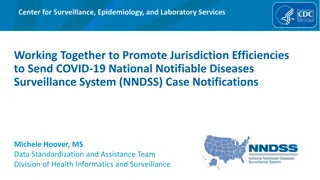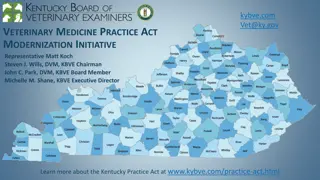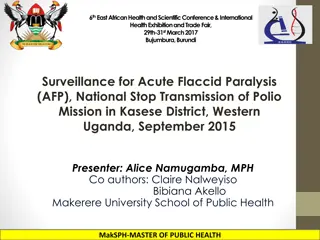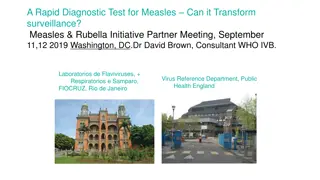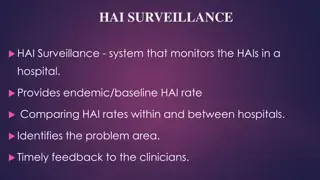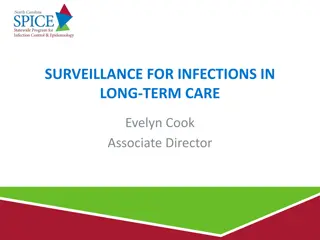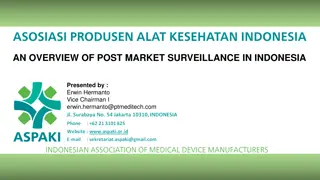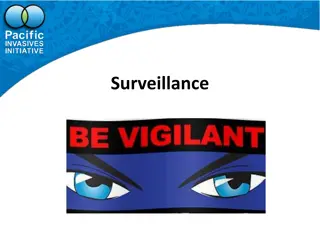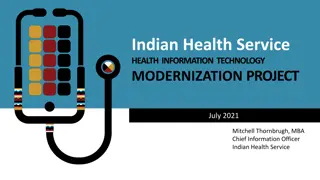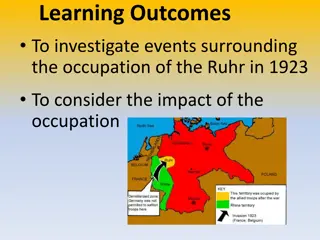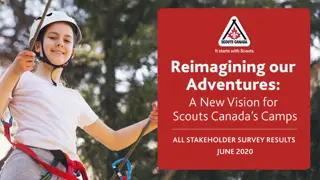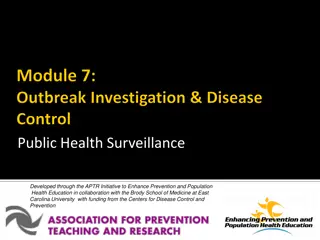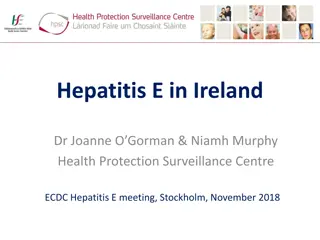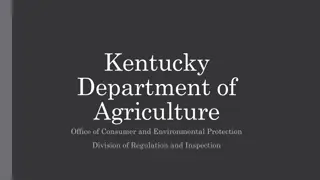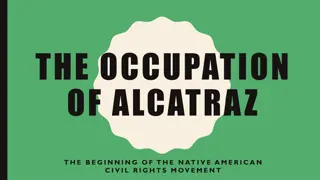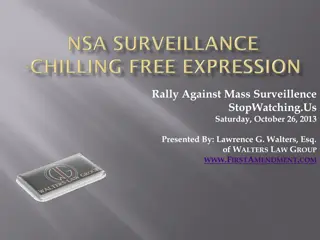Industry and Occupation Surveillance Data Modernization Initiative
The Center for Surveillance, Epidemiology, and Laboratory Services is spearheading the NNDSS Modernization Initiative to capture industry and occupation surveillance data. The initiative includes a new industry and occupation message mapping guide template and the demonstration of the NIOSH Industry and Occupation Computerized Coding System. Collaboration between DHIS and NIOSH aims to enhance data collection and utilization for disease notifications. The incorporation of occupation data into disease surveillance efforts is a key priority for public health monitoring and response.
Uploaded on Oct 10, 2024 | 2 Views
Download Presentation

Please find below an Image/Link to download the presentation.
The content on the website is provided AS IS for your information and personal use only. It may not be sold, licensed, or shared on other websites without obtaining consent from the author.If you encounter any issues during the download, it is possible that the publisher has removed the file from their server.
You are allowed to download the files provided on this website for personal or commercial use, subject to the condition that they are used lawfully. All files are the property of their respective owners.
The content on the website is provided AS IS for your information and personal use only. It may not be sold, licensed, or shared on other websites without obtaining consent from the author.
E N D
Presentation Transcript
Center for Surveillance, Epidemiology, and Laboratory Services NNDSS Modernization Initiative (NMI): Capturing Industry and Occupation Surveillance Data Subscribe to monthly NMI Notes news updates at https://www.cdc.gov/nndss/trc/news/index.html! Access the NNDSS Technical Resource Center at https://www.cdc.gov/nndss/trc/index.html! July 18, 2017 Division of Health Informatics and Surveillance
Agenda Welcome Presentation of New Industry and Occupation Message Mapping Guide Template Demonstration of NIOSH Industry and Occupation Computerized Coding System (NIOCCS) Tool State s Perspective on Collecting Industry and Occupation Data Hot Topic: Unique Identifiers for Cases in Disease Notifications General Questions and Answers 2
Center for Surveillance, Epidemiology, and Laboratory Services New Industry and Occupation Template for Message Mapping Guides Ruth Jajosky, DMD, MPH Office of Public Health Scientific Service Division of Health Informatics and Surveillance Center for Surveillance, Epidemiology, and Laboratory Services Centers for Disease Control and Prevention
Industry and Occupation Template for Message Mapping Guides (MMGs) Purpose: To facilitate NIOSH S and Programs exploration of potential relationships between specific diseases/conditions and specific occupations and/or industries. Current Status: Incorporating the template into MMGs, starting with Mumps, Pertussis, and Varicella MMGs. Next Steps: - Continue incorporating the template into future MMGs - DHIS and NIOSH will engage in ongoing collaborations to facilitate discussions with the jurisdictions related to the feasibility of data collection and usefulness of the data. The template may be revised based upon these findings. - Eventually incorporate template into the Generic v.3 MMG 4
Center for Surveillance, Epidemiology, and Laboratory Services Demonstration of NIOSH Industry and Occupation Computerized Coding System (NIOCCS) Tool Pam Schumacher Technical Information Specialist Surveillance Branch, DSHEFS, National Institute for Occupational Safety and Health (NIOSH)
Incorporating Occupation Data into an Integrated Surveillance System: Collaboration between Infectious Disease & Occupational Health T. Scott Troppy, MPH, PMP Office of Integrated Surveillance and Informatics Services Bureau of Infectious Disease and Laboratory Sciences 12
MAVEN Features Complete data capture in single integrated system across BIDLS co-infection analysis ELR/ eCR interface Real-time information sharing Automated triage of information streamlined case investigation and surveillance Contact investigations Outbreak response Ability to capture occupation information 13
Milestones MAVEN(Massachusetts Virtual Epidemiologic Network) 2006-07: vaccine preventable, zoonotic, viral hepatitis, general epidemiology and enteric diseases, TB case management 2009-10: H1N1 response, on- call, rabies, outbreak management, RIHP module 2011-13: ESPnet integration, Communication events 2014-15: STI Module, Food Protection Program Modules, Vibrio, HIV Phase I and II, Ebola 2016: Zika, HIV Phase III, data and legal requests 2017: infection preventionists Over 600 active users State: BIDLS, DHCSQ, DMF and BEH >95% of local boards of health Clinical Practitioner Role (proof of concept) 14
Occupation Process Initiated discussion in 2007 with Occupational Health Surveillance Program inform Occupational Health Surveillance Program, Division of Health Care Safety & Quality, and Environmental Health of cases of relevance for potential risk Tularemia/Landscaper, Enteric/Food handler, Animal Exposures/Veterinary Update current reference code list for occupation list 15
Distribution of Occupations in Massachusetts CPS 2013 Occupation Office and administrative support occupations Management occupations Sales and related occupations Education, training, and library occupations Business and financial operations occupations Healthcare practitioner and technical occupations Food preparation and serving related occupations Construction and extraction occupations % Occupation Building and grounds cleaning and maintenance occupations Healthcare support occupations Arts, design, entertainment, sports, and media occupations Installation, maintenance, and repair occupations Community and social service occupations Architecture and engineering occupations Life, physical, and social service occupations Protective service occupations Legal occupations Farming, fishing, and forestry occupations Armed Forces % 12.3 10.9 9.1 3.8 3.0 2.7 7.3 2.3 6.4 2.2 5.9 2.1 5.4 2.0 1.8 1.7 4.5 Personal care and service occupations Transportation and material moving occupations Computer and mathematical science occupations 4.3 0.2 0.0 4.1 17 4.1
Implementing updated reference list in MAVEN May 2014 updated occupation reference list for the new Foodborne Illness Complaint model March 2015 updated reference list for MAVEN core product to apply to all models and disease product codes 18
Standard Occupational Classification (SOC) Reference List (MAVEN) SOC list 19
Foodhandler Changes Original (1) Updated (10) 20
Occupation Groups for Animal Related (MAVEN) 21
Occupation DATA ANALYSIS 22
Occupation Data Analysis Enteric Cases (April 2015-December 2016) Total enteric events from MAVEN (April 2015-December 2016) N=8,688 Missing Excluded cases w/o occupation info 2,725 (31%) Occupation field completed N=5,963 (69%) Child (943) Student (606) Unemployed (540) Retired (919) Excluded non-working cases 3008 (35%) Other please specify 1,224 (14.4%) Unknown (188) Other non-specified (79) Excluded cases with non-specific info 267 (3%) Working cases with text to code 2,688 (31%) Not enough info to code to MDPH list or SOC (421) Excluded cases that can t be coded 421(5%) Enteric cases with occupation for analysis 2,267 (26%) 23 Data Source: MAVEN, April 2015 Dec 2017
Occupation Data Analysis Enteric Cases (April 2015-December 2016) Working cases with useable text N=2,688 Excluded cases that can t be coded 421 (16%) Coded to SOC only by NIOCCS 307 (11%) Coded to SOC only manually 145 (5%) SOC coding Cases with coded occupation text for analysis 2,267 (84%) Code to MDPH pick list & SOC 1,701 (63%) Code to SOC only 452 (17%) MDPH pick list only 114 (4%) Code to MDPH pick list 1,815 (68%) Code to SOC 2,153 (80%) 24 Data Source: MAVEN, April 2015 Dec 2017
Distribution of Occupation within Enteric Diseases by MDPH Occupation Group, N=1,815 Postal worker MDPH Reference list for occupations Police officer / Firefighter / Correctional officer Landscaper, grounds maintenance worker Hairdresser / Barber / Nail technician Human services worker / Public health worker Animal related Transportation and material moving Engineers Computer specialist Construction / Plumber Sales and related occupations Teacher / Day care worker Business and financial operations Food service Medical professional Office & Administrative 0 5 10 15 20 25 Percent Data Source: MAVEN, April 2015 Dec 2017
Distribution of Occupation within Enteric Diseases by SOC Occupation Group, N=2,153 Other (11, 19, 49, 45 ,55) 33 - Protective Service Occupations 51 - Production Occupations 27 - Arts, Design, Entertainment, Sports, and Media 21 - Community and Social Services Occupations SOC 2-digit occupations 23 - Legal Occupations 37 - Building and Grounds Cleaning Occupations 53 - Transportation and Material Moving Occupations 31 - Healthcare Support Occupations 17 - Architecture and Engineering Occupations 39 - Personal Care and Service Occupations 15 - Computer and Mathematical Occupations 29 - Healthcare Practitioners and Technical 47 - Construction and Extraction Occupations 35 - Food Preparation and Serving Related 25 - Education, Training, and Library Occupations 41 - Sales and Related Occupations 13 - Business and Financial Operations 43 - Office and Administrative Support Occupations 0 5 10 15 20 Percent 26 Data Source: MAVEN, April 2015 Dec 2017
Mechanisms to improve completeness of Occupation variable ENTERIC DISEASE EVENTS 27
Concerns for Salmonellosis For Salmonellosis and other enteric diseases, the following concern was developed: Please note the case s occupation in the Demographic Question Package. color-coded reminders to complete information specific to a disease event implemented in 2013 for all enteric disease events 28
Salmonellosis Completeness of Occupation information between 2013 and 2014 20% Number of Confirmed Cases 50% N=228 Odds Ratio:3.95; 95% Confidence Interval: 3.28, 4.76; p-value <0.0001 N=576 Events in 2014 were 4 times more likely to have Occupation completed Events in 2014 were 4 times more likely to have Occupation completed compared to events in 2013 compared to events in 2013 29
Manual Process Tularemia/Landscaper daily Epi-of- the-day notes reviewed by surveillance staff and then notify OHSP 30
Next Steps Create additional variables in MAVEN to identify potential work related risk Incorporate OHSP into MAVEN workflows to identify cases of relevance Extract data for OHSP on an on-going basis for review and analysis Use data to identify emerging hazards and occupations at risk Work with OHSP to develop prevention material where relevant Determine process for updating reference code list when needed 31
More information Scott Troppy Bureau of Infectious Diseases and Laboratory Sciences scott.troppy@state.ma.us 617-983-6819 Angela Laramie Massachusetts Occupational Health Surveillance Program angela.Laramie@state.ma.us 617-624-5641 32
Center for Surveillance, Epidemiology, and Laboratory Services Hot Topic: Proposed Change to Unique Case Identifier in Disease Notifications sent to MVPS Lesliann Helmus, MS, CHTS-CP NNDSS Program Manager Division of Health Informatics and Surveillance Center for Surveillance, Epidemiology, and Laboratory Services Centers for Disease Control and Prevention
NNDSS approaches to Unique Case ID System/Message Data Elements NETSS CaseID + State + Site ID + MMWR Year NBS Master Message Local Record ID + State Code Old HL7 messages Local Record ID + State Code MVPS Local Record ID + National Reporting Jurisdiction + Date first electronically submitted * CaseID and Local Record ID both represent the case identifier in the jurisdiction surveillance system Presumed benefits of including Date first electronically submitted : Historically, some states re-used case IDs from year to year States with multiple surveillance systems could conceivably have two cases with the same ID Observed drawbacks based on experience with ~25 states: Some states have had difficulty sending the value reliably (failures resulted in numerous duplicates) Many surveillance systems were not designed to capture and store this value Extensive programming may be required to capture and store It is difficult to maintain the value when states migrate data to a new surveillance system 34
Proposed strategy Recommended change: Use Local Record ID + National Reporting Jurisdiction as unique case ID in MVPS Remove Date first electronically submitted from MVPS calculation of unique case identifier Hold jurisdictions responsible for ensuring that Local Record ID is unique within jurisdiction Considerations for states: If system re-uses identifiers annually: add year indicator (e.g., year case created) If multiple surveillance systems are use: add system indicator If sub-jurisdictions use their own systems: add a system or sub-jurisdiction indicator If migrating between systems: incorporate original Local Record ID in Legacy Case ID field in new system Thoughts? 35
Upcoming eSHARE Webinars August 15 Panel Presentation of States Onboarded to MVPS to Discuss Barriers, Challenges, and Lessons Learned. 36
Subscribe to monthly NMI Notes news updates at https://www.cdc.gov/nndss/trc/news/index.html! Access the NNDSS Technical Resource Center at https://www.cdc.gov/nndss/trc/index.html! Request NMI technical assistance or onboarding at edx@cdc.gov! Next NMI eSHARE is August 15, 2017 details at https://www.cdc.gov/nndss/trc/onboarding/eshare.html! For more information, contact CDC 1-800-CDC-INFO (232-4636) TTY: 1-888-232-6348 www.cdc.gov The findings and conclusions in this report are those of the authors and do not necessarily represent the official position of the Centers for Disease Control and Prevention. 38





